
Greenhouse gas emissions along with energy consumption, depletion of water resources, and chemical emissions into the atmosphere or water/soil resources, all of which are attributable to the Hodogaya Chemical Group’s business activities, can affect the environment.
Therefore, we consider continuously reducing all types of chemical emissions and waste as one of the important missions of chemical manufacturers and strive to address environmental preservation issues from both perspectives—reducing the environmental burdens arising from business activities and appropriately managing chemicals to minimize the impact of our business activities on the environment.
Based on the “Basic Philosophy of RC”, Hodogaya Chemical Group obtained a certification for all Japanese offices for the environmental management system (ISO 14001) in 2001.
This system was integrated across all group company locations in Japan in 2010, and after obtaining an integrated certification, the percentage of certified group companies in Japan was 100% as of FY2023.
Also, we have employed environmental accounting to identify the costs and effects of our environmental preservation activities and smoothly implement environmental management.
| Certification body | Japan Chemical Quality Assurance |
| Registration no. | JCQA‑E‑0330 |
| Compatible standards | JIS Q 14001:2015 ISO 14001:2015 |
| Date of acquisition | December 25, 2001 |
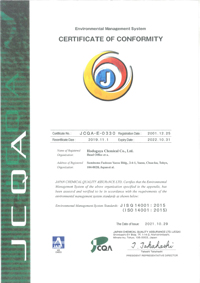

The Hodogaya Chemical Group considers responding to climate change to be a crucial management challenge. We have been actively promoting initiatives to reduce greenhouse gas (GHG) emissions, in order to fulfill our responsibilities toward the realization of a sustainable planet and society as set forth in the VISION of our Mid-term Management Plan.
Most of the GHG emitted by Hodogaya Chemical is CO2*1. The GHG emissions for FY2023 are 35,649 t-CO2 (Scope 1*2 + Scope 2*3). We will continue to work on reducing emissions through the introduction of energy-saving equipment and switching to renewable energy sources based on long-term decarbonization investments to reduce energy intensity. Regarding Scope 3*4, we are currently at the stage of gathering information on other companies’ initiatives.
We will continue to grasp our GHG emissions for each Scope, analyze the results, formulate reduction plans, and strive to reduce GHG emissions according to the plans.
In addition to cool biz, we introduced a no-necktie policy year round, and since November 2021, we have had a year-round business casual policy. At the offices, we also have sensible events such as a no-car day.
*1 Non-energy-originated CO2 emissions are not included
*2 Scope 1: Direct emissions
*3 Scope 2: Energy-originated indirect emissions
*4 Scope 3: Other indirect emissions, classified into 15 categories
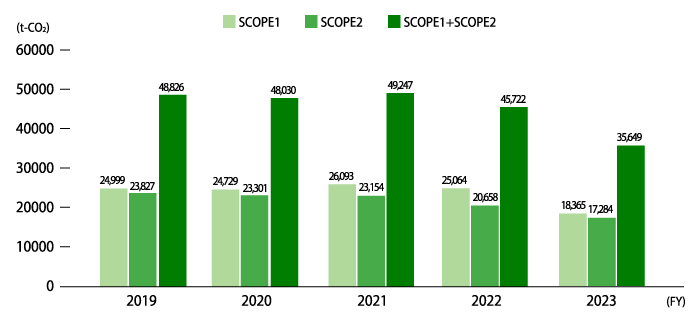
SOx (sulfur oxide), NOx (nitrogen oxide), and dust are discharged from our factories from the burning of fuel and other aspects of chemical manufacturing. In FY2011, Hodogaya Chemical completed a switch to city gas for the raw fuel used in our plants, which has allowed us to continue to achieve zero emission of SOx since FY2012. We are also achieving significant reduction of NOx and dust emissions through measures such as adopting dust collectors and scrubbing towers, and using catalyzers. This has allowed us to mitigate discharge of these substances into the atmosphere.
Prevention of air pollution
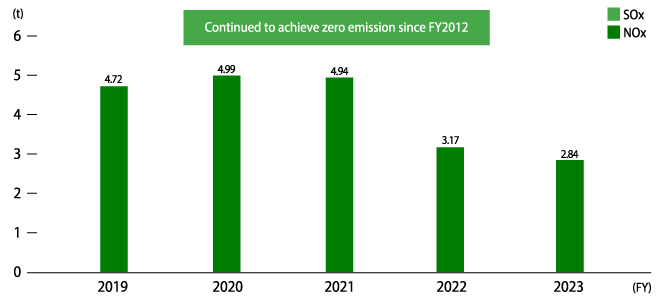
Based on an analysis of water stress in the area where our factories are located using the water risk evaluation tool AQUEDUCT from the World Resources Institute (WRI), Koriyama and Shunan are low to medium, and Yokohama is medium to high. No water is taken from areas considered high.
There has been no change even after 50 years. Of the 9,853 tons of water used by our factories in FY2023, 99% is procured from rivers and streams and does not stress the water supply. Only a small amount, about 1%, of the water supply we use is for drinking water. Moreover, we do not use groundwater that could cause land subsidence.
We consider the effective use of water resources as the foundation of our sustainable production activities, and we strive to conserve rivers located nearby our factories.
Water released during the manufacturing process is treated in an advanced manner at the on‑site wastewater treatment facility within the plant, and released into the public waters after the water quality clears regulatory values.
In FY 2023, we will continue to strive to improve the water quality and work to reduce the environmental impact risks to oceans and rivers without violating our standards for water usage and quality.
Prevention of water pollution
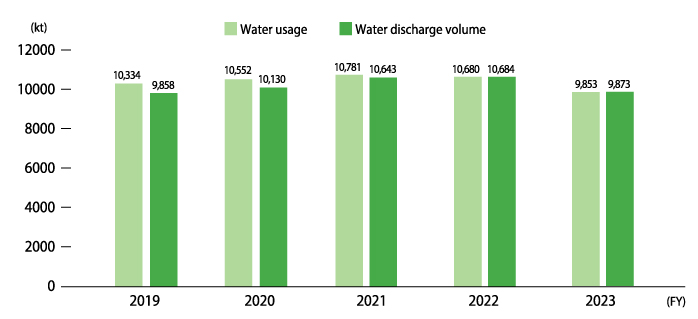
The Hodogaya Chemical Group promotes the 3R+Renewable initiative (reduce, reuse, recycle, renewable) for waste materials. In our midterm business plan, we promoted reducing the volume generated compared with the previous fiscal year as a KPI. The total emissions for FY2023 decreased by 27% and the final disposal volume for FY2023 increased by 69% respectively compared to the previous fiscal year While there are influences from differences in production item composition, we take seriously the fact that the final disposal volume has increased and will strengthen our efforts to reduce industrial waste. Additionally, based on the Plastic Resource Circulation Act, which went into effect on April 1, 2022, we tried to reduce industrial waste from plastic products generated in the course of our business activities, which amounted to 110 t in FY2023.
Industrial waste reduction
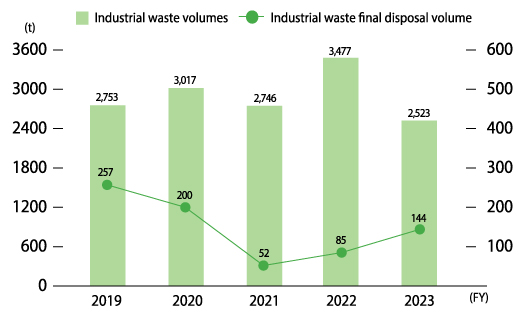
In order to reduce the amount of chemical substances that are harmful to the environment, Hodogaya Chemical ascertains the release and transfer of PRTR-listed substances and reports them to the national authorities in line with the PRTR Act (Pollutant Release and Transfer Register). Hodogaya Chemical handles 23 of the 462 substances defined in the PRTR Act as Class 1 Designated Chemical Substances. From the perspective of environmental conservation, we will ascertain the actual status of chemical substance emissions and transfers of waste into the environment, while continuing to strive to work to reduce the amounts of such substances released and transferred.
* PRTR:Pollutant Release Transfer Register
FY2023 release amounts and transfer amounts of PRTR listed substances
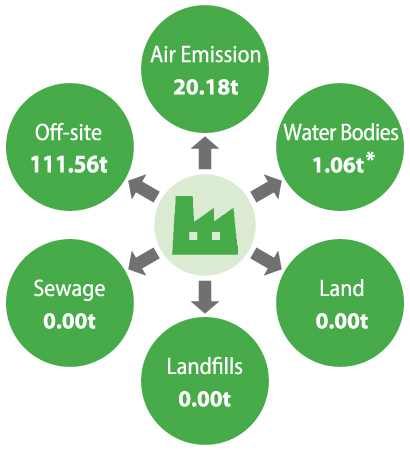
* Of which 1.06 tons have been sent to the adjacent wastewater treatment facility and released into the public water bodies after being treated.
Since FY2021, the Hodogaya Chemical Group has adopted environmental accounting and data compilation in order to quantify the resources we invest in the environment and use them for environmental management.
Of the major expenditures related to environmental conservation in FY2023, the largest expense was resource recycling costs, which amounted to 138 million JPY.
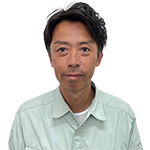
Manufacturing Department,
Yokohama Plant
T.S
In recent years, global warming has become a serious issue. As economic activities develop, CO2 emissions increase, and consequently, the global average temperature rises. As a result, extreme weather events such as concentrated heavy rainfall and high temperatures are occurring worldwide, causing serious impacts.
In light of this situation, the Yokohama Plant has been working on CO2 reduction by switching to CO2– free electricity for power trading since April 2022. We are also working on reducing power consumption by replacing mercury lamps and fluorescent lights with LEDs. In our current efforts, we are also responding to external requests for power savings.
While the plant implements various initiatives for “environmentally friendly manufacturing,” I believe the most important thing is for each employee working at the plant to act with awareness. In the future, we would like to continue working on reducing environmental impact throughout the entire plant.
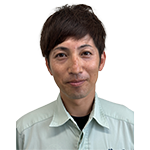
Koriyama Plant
T.O
Energy forms an essential element in our lives. However, global warming brought about by energy consumption has become a serious problem, and energy conservation is now an important issue on a global scale. As an energy saving initiative at the Koriyama Plant, we installed an ICP system-based heat pump in December 2022 to make effective use of the waste hot water, which had not previously been used, after the heat exchange process. Using this waste water as a heat source and efficiently heating boiler feed water is expected to reduce emissions by 171t-CO2/year and city gas consumption by 113,000Nm3/year. There are many other energy-saving initiatives we can usefully do ourselves, such as saving electricity and water, rather than by installing equipment. Aware of the need to mitigate the effects of global warming, each and every person working at the Koriyama Plant will continue to engage in energy-saving activities.
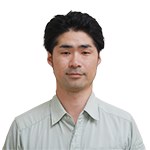
Koriyama Plant
S.H
Until now, energy conservation has been implemented mainly for cost reduction reasons. While this practice hasn’t changed until today, it is becoming more and more important as a means of solving social issues such as the prevention of global warming and ensuring a stable supply ofenergy. Energy, such as fuel and electricity, is indispensable for manufacturing products. The Koriyama Plant in particular, consumes a large amount of energy, and according to calculations based on the Energy Conservation Act, it accounts for approximately 70% of the energy consumption of our three domestic plants.
As an energy manager, my role is to improve the efficiency of energy use, that is, to promote energy conservation. With the introduction of highly-efficient equipment and the reduction and reuse of waste energy as measures related to production, all workplaces are working together to fulfil their social responsibility by focusing on energy conversation of daily usage not directly linked to production, such as lighting and air-conditioning.
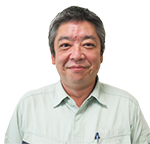
Nanyo Plant
K.F
At the Nanyo Plant, with the target of improving our year‑on‑year recycling rate and cutting the amount of industrial waste that goes into landfills, we are pursuing the following FY2021 environmental conservation initiatives:

HODOGAYA AGROTECH Co., Ltd.
Y.H
When developing agricultural chemicals, it is of critical importance to ensure that users can safely utilize the chemicals to control weeds or pests, and to ensure that the impact of sprayed agricultural chemicals on the surrounding environment, including aquatic plants and animals, is minimal. By modifying the pharmaceutical formulation of products and the equipment used for spraying, it is possible to curb the impact on aquatic plants and animals, as well as reduce human exposure and dispersal into the surrounding area.
In recent years, some infrastructure and transportation-related companies have been setting their own safety standards for the agricultural chemicals they use, and some even ban the use of products labelled with a warning that they could potentially impact aquatic plants and animals. Most of the herbicides currently sold in Japan are labelled with this warning, but we modified the active ingredients, their respective amounts, and the pharmaceutical formulation to develop and start selling a highly effective herbicide with a reduced impact on aquatic plants and animals. I intend to continue working on product development, keeping safety and the environment in mind as I do so.

Koriyama Plant
S.S
I work as a manager responsible for preventing water pollution. My work includes interpreting analysis data for water discharged by each manufacturing process as well as overall water discharge, monitoring water quality, and filing notifications with governmental authorities and others.
The Koriyama Plant manufactures products such as hydrogen peroxide and hydrogen peroxide derivatives, charge control agents and organic photo conductors used in copiers, and aluminum coloring dyes. The water discharged by the associated manufacturing processes is treated at a central wastewater treatment facility, then discharged into the Ouse River, a Class A river (as defined in Japan’s River Act) within the water system of the Abukuma River, which runs through the city of Koriyama. We therefore conduct monitoring and measurement according to standards we have set ourselves, which are even more stringent than the statutory water discharge standards. If there is even the slightest change in water quality, we immediately contact the relevant department and discuss the situation with them, then deliberate on and implement an investigation into the cause, along with improvement measures.
Everybody at the plant will continue working as one to maintain and improve the quality of our wastewater so that the koi carp and dragonfly larvae in the Ouse River can continue to live there undisturbed.
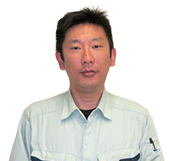
Tsukuba Research Laboratory
M.A
To reduce paper waste, we try to reduce the amounts generated and also as a community contribution effort, we ask a social welfare corporation operating a support facility for persons with disabilities in Tsukuba City to collect and recycle paper waste. They come to collect the paper waste once a week.
When we have a small chat, they are all so pleasant that I get cheered up. I also feel that recycling the paper waste is beneficial to the welfare activities, even if just by a small amount.
To reduce glass waste, we used to take the glass bottles to the waste storage, which took up space. After consulting with the supplier, we are now able to return and reuse them by drying the bottles. We no longer worry about securing space for waste.

Environment・Safety & Quality
Assurance Department
S.S
Some of the things I take note as an ISO internal auditor include whether the documents assessing the environmental impact of our products are properly produced, and whether the concept of product lifecycle from procurement of raw materials and manufacturing to disposal and recycle is integrated in the product development process. Once we actually conduct the audit, we can clearly see that the progress of specific initiatives to resolve issues are properly documented, and training sessions are well planned.
Continuous efforts must be made to protect the environment. I believe that our Company can continue to help protect the environment as a chemicals company through the provision of materials that could limit the product’s power consumption or through development of herbicides and pesticides that are friendly to the ecosystem.